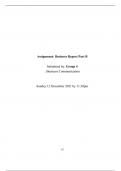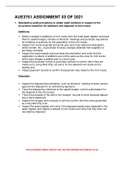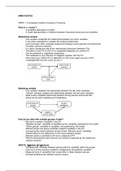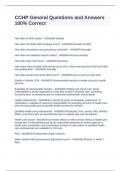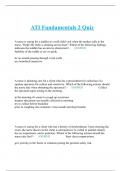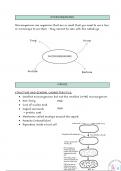Architectuur in Context A
0. Intro
0.1 wat is architectuur
0.2 wat is geschiedenis
0.3 wat is architectuurgeschiedenis
LES 1: GRIEKS
1. Inleiding: Griekenland vs Rome
Gelijkenissen
Verschillen (maatschappelijke indeling, invloeden van culturen en omgang daarmee,
architraafbouw vs koepels en gewelven
Piranesi vs Winckelman
2. Verenigd in de diversiteit: de polis
Griekse antieke wereld
Kleinschalige politiek en arch, focus op details
Pan-Hellenisme
Belangrijkste stadstaten
stijlfases
3. De proto-Griekse erfenis
Minoïsche beschaving (polychromie, realisme, megarongrondplan, fronton, H en V)
o Minos
o Kreta, Knossos
o Handel
o Paleis van Knossos
Myceense beschaving
o Agamemnon
o Vaste land
4. Het perfectioneren van de orde als opdracht voor de goden
4.1 algemene kenmerken van de ordes
4.2 archaïsche fase: perfectionering van het tempelplan en de orde
Dorische volk politieke bovenhand
Hera I vs Hera II
o Entasis
o Echinus
o N = 2a + 1
o Gutae
Beeldhouwkunst (Hittorf)
4.3 klassieke fase: architectuur, kunst en wetenschap
Athene
Perikles
Acropolis (Parthenon, propyleeën)
o Perfectionering grondplan
o Sculptuur
o Inplanting
, 4.4 hellenistische fase: de plaats van het individu in het imperium
Alexander De Grote
Culturele verschuiving (oosterse invloeden)
Pergamon altaar (Berlijn)
Propaganda
Overgang polis naar imperium
LES 2: ROMEINS
1. Inleiding:
1.1 Winckelman vs Piranesi
1.2 Basiskenmerken volgens Vitruvius
De Architectura
o Tweevoudig belang
o Populariteit in renaissance
o Vooral over Rome tijdens republiek
o 10 delen (concreet beeld architectuur, verschillende schalen)
o Augustus
Ingenieur
Architectuur als wetenschap
Als één van de hoekstenen (politiek, economie, recht)
Voor het construeren van een imperium (bouwen + organiseren)
Menselijke schaal
Basiskenmerken
o Venustas – schoonheid
o Firmitas – stevigheid
o Utilitas – nut, functie
1.3 Architectuur als maatschappelijk fenomeen
+ commoditas – propaganda, rijkdom (Romeinse barok)
Citaat Le Corbusier
Palmyra
2. Assimilatie, technisch vernuft, functionalisme en barok
2.1 Assimilatie (venustas)
Verschillende invloeden ( Etruskisch, Helleens,Oosters)
Etrusken (Italië)
o Invloed via materiaal, sculptuur, Toscaanse orde, bogen
o Grote en ondergrondse zaken bewaard
o Etruskische tempel
Maison Carrée (Nîmes)
Fortuna Primigenia tempel (Palestina)
Tempel van Baal (Palmyra)
Venustempel van Baalbek
2.2 Constructieve vernieuwing: gewelf, beton, baksteen (firmitas)
Voor RR
Porta Augusta + Etruskische boog (Valterra)
Voordelen
0. Intro
0.1 wat is architectuur
0.2 wat is geschiedenis
0.3 wat is architectuurgeschiedenis
LES 1: GRIEKS
1. Inleiding: Griekenland vs Rome
Gelijkenissen
Verschillen (maatschappelijke indeling, invloeden van culturen en omgang daarmee,
architraafbouw vs koepels en gewelven
Piranesi vs Winckelman
2. Verenigd in de diversiteit: de polis
Griekse antieke wereld
Kleinschalige politiek en arch, focus op details
Pan-Hellenisme
Belangrijkste stadstaten
stijlfases
3. De proto-Griekse erfenis
Minoïsche beschaving (polychromie, realisme, megarongrondplan, fronton, H en V)
o Minos
o Kreta, Knossos
o Handel
o Paleis van Knossos
Myceense beschaving
o Agamemnon
o Vaste land
4. Het perfectioneren van de orde als opdracht voor de goden
4.1 algemene kenmerken van de ordes
4.2 archaïsche fase: perfectionering van het tempelplan en de orde
Dorische volk politieke bovenhand
Hera I vs Hera II
o Entasis
o Echinus
o N = 2a + 1
o Gutae
Beeldhouwkunst (Hittorf)
4.3 klassieke fase: architectuur, kunst en wetenschap
Athene
Perikles
Acropolis (Parthenon, propyleeën)
o Perfectionering grondplan
o Sculptuur
o Inplanting
, 4.4 hellenistische fase: de plaats van het individu in het imperium
Alexander De Grote
Culturele verschuiving (oosterse invloeden)
Pergamon altaar (Berlijn)
Propaganda
Overgang polis naar imperium
LES 2: ROMEINS
1. Inleiding:
1.1 Winckelman vs Piranesi
1.2 Basiskenmerken volgens Vitruvius
De Architectura
o Tweevoudig belang
o Populariteit in renaissance
o Vooral over Rome tijdens republiek
o 10 delen (concreet beeld architectuur, verschillende schalen)
o Augustus
Ingenieur
Architectuur als wetenschap
Als één van de hoekstenen (politiek, economie, recht)
Voor het construeren van een imperium (bouwen + organiseren)
Menselijke schaal
Basiskenmerken
o Venustas – schoonheid
o Firmitas – stevigheid
o Utilitas – nut, functie
1.3 Architectuur als maatschappelijk fenomeen
+ commoditas – propaganda, rijkdom (Romeinse barok)
Citaat Le Corbusier
Palmyra
2. Assimilatie, technisch vernuft, functionalisme en barok
2.1 Assimilatie (venustas)
Verschillende invloeden ( Etruskisch, Helleens,Oosters)
Etrusken (Italië)
o Invloed via materiaal, sculptuur, Toscaanse orde, bogen
o Grote en ondergrondse zaken bewaard
o Etruskische tempel
Maison Carrée (Nîmes)
Fortuna Primigenia tempel (Palestina)
Tempel van Baal (Palmyra)
Venustempel van Baalbek
2.2 Constructieve vernieuwing: gewelf, beton, baksteen (firmitas)
Voor RR
Porta Augusta + Etruskische boog (Valterra)
Voordelen



